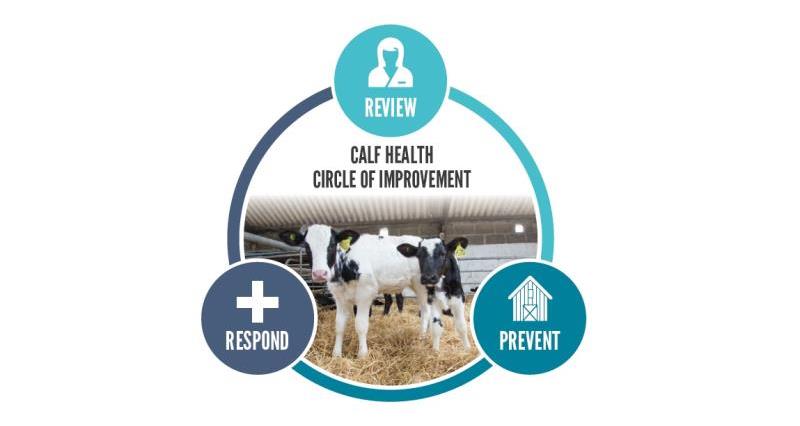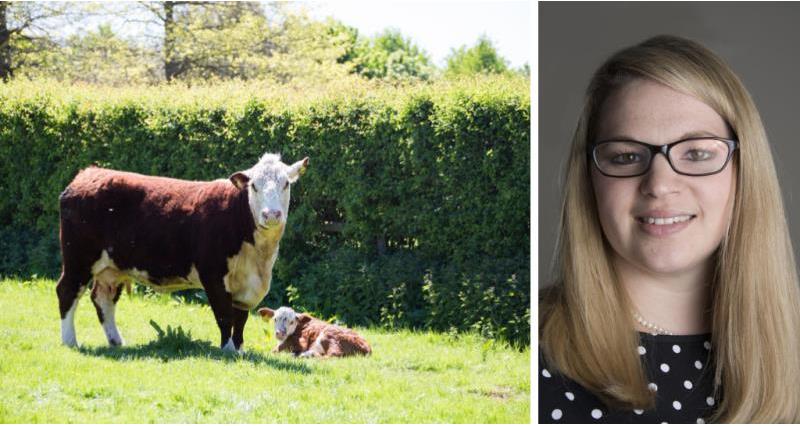Optimising calf health is really important for the welfare of animals but also for productivity – getting it right can mean better survivability, better live weight gains for beef animals and a shorter time to first calving for dairy calves, plus you could reduce your medicine usage.
NFU animal health and welfare adviser, Rebecca Veale, explains more:

The cattle antibiotic groups have put together a circle of health improvement with three key areas – respond, review and prevent. Which are the three key areas that can be addressed in a calf health plan.
The bit to start with is addressing the problems that are there now by treating the diseases which are affecting your calves. If you don’t already talk to your vet about these then now is the time, they need to diagnose and prescribe medicines appropriate to the problem. Are there any early indicators of disease? And don’t forget to record the issues and treatments because that will help the next stage.
While the vet is there, talk to them about what has been going on over the last few years, have they worsened, is there a pattern? If you rear calves is it certain batches that are the problem?
The review is useful because it will flag up the things that could be addressed to prevent further issues. It’s all bespoke to your farm but there are some key things that will help with the review, and that you can address in the third stage, prevention.
Colostrum – get this bit right and you reduce the risk of other things going wrong. While there's a lot of advice on colostrum management, it takes work because you have to be on top of it for every calf but preventing disease can mean you save lots of money on medicines.
The three Q’s help – Quickly, Quantity and Quality – the ideal time for calves to receive their first colostrum is within two hours. The recommendations also say they need three litres in the first six hours (or 10% of body weight) and another feed of three litres within 12 hours. Feeding poor colostrum negates the whole process so it should contain at least 50g/l of IgG. The AHDB calf management booklet has some great advice, and it is laminated.
Environment – respiratory problems are common in calves so consider the temperature, moisture, fresh air and airspeed.
Hygiene – there are different aspects of hygiene involved, environmental, colostrum, feeding, personal biosecurity and for any treatments. Keeping the environment, equipment and those working with the calves clean sounds simple but it takes work to maintain at busy times so make a solid part of the routine.
Biosecurity – when bringing groups of calves together make sure you’re not mixing less healthy calves with those in better health. Mixing groups is stressful for calves and so can exasperate health issues and diseases. Planning and managing what you bring in and how groups are mixed can be difficult but will definitely make a positive difference.
Vaccines – they are not the silver bullet but they are an incredibly important tool. If you’ve got problems with diseases such as pneumonia, E.Coli, blackleg, Chlostridia (the list goes on…) then there are options. But it is really important to discuss this with your vet. And if you decide vaccines are the way forward then make sure you look after them and administer them properly – why pay lots of money for it to be too hot or cold or an insufficient dose to work?
There's a lot to consider but often getting the environment and colostrum right will make a huge difference.
The circle of calf health is a circle for a reason – continually responding, reviewing and preventing disease will ensure you’re ahead of the game, because things will and do change and your plan will make whatever comes your way that bit easier.
